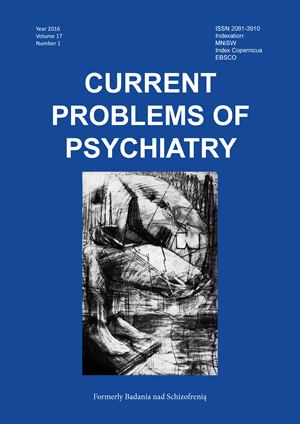Historia histerii i co dalej…
DOI:
https://doi.org/10.1515/cpp-2016-0005Słowa kluczowe:
histeria, zaburzenia dysocjacyjne, hipnozaAbstrakt
Począwszy od starożytności aż po nasze dni histeria jest zagadnieniem tajemniczym i intrygującym. Autorzy niniejszego artykułu posiłkując się, w głównej mierze, dziełem Etienne Trillat, o tym samym tytule, przedstawiają najważniejsze fakty z dziejów histerii. Praca ukazuje jak krok po kroku ewoluowały wyobrażenia o histerii znanej początkowo jako duszności maciczne, którym to terminem posługiwał się sam Hipokrates w VII tomie swoich "Dzieł wszystkich". Pod koniec I wieku naszej ery przybyły do Rzymu Soranos z Efezu, jako wytrawny anatom, w swoim "Traktacie o chorobach kobiecych" odszedł od starych koncepcji Platona i Hipokratesa przyrównujących macicę do zwierzęcia. Jak kształtowały się poglądy na histerię w średniowieczu, renesansie czy okresie wojen światowych? W artykule tym autorzy próbują ustalić naturę histerii a także co z histerii pozostało we współczesności, obrazując tym samym pewną nieuchwytność histerii jako choroby, wiele trudności z jej zdefiniowaniem oraz związek z wieloma szokującymi wręcz wydarzeniami w historii człowieka. Od mędrców starożytnych przez Kramera, Sprengera, Wiera, Harveya, Willisa, Sydenhama, Blackmore'a, po Mesmera, Freuda i innych. Od histeryczek-czarownic, istot cierpiących na wapory, przez osoby wrażliwe, delikatne i marzycielskie po mitomanki, lubieżnice i to, co współcześnie określamy osobowością histrioniczną. Zdaniem wybitnego francuskiego neurologa i twórcy psychiatrii - Charcota - histeria istniała zawsze, wszędzie i od wszechczasów. Dlaczego jednak zanikła? Autorzy artykułu w końcowej części pochylają się i nad tym problemem, próbując ustalić jego przyczyny.Bibliografia
1. Etienne Trillat „Historia histerii“ Wrocław Warszawa Kraków Zakład Narodowy imienia Ossolińskich Wydawnictwo 1993
2. „Pomiędzy wiarą a nauką: zniewolenie duszy czy zaburzenia dysocjacyjne? Prezentacja przypadku.“ Psychiatria Polska 2012, tom XLVI, numer 2, strony 305-312.
3. Dysocjacja: różnorodność kontekstów i znaczeń. Próba klaryfikacji. Monika Matecka, Jowita Wycisk, Czasopismo Psychologiczne, 2003, 9, 2.
4. „Women And Hysteria In The History Of Mental Health“ Cecilia Tasca, Mariangela Rapetti, Mauro Giovanni Carta, Bianca Fadda, Clinical Practice and Epidemiology in Mental Health, 2012, 8, 110-119.
5. Krzysztof Owczarek „Zaburzenia dysocjacyjne w praktyce klinicznej“ Postępy Psychiatrii i Neurologii 2002, 11, 131-137.
6. Stefan Leder „Poglądy na nerwice w ujęciu historycznym“ Postępy Psychiatrii i Neurologii 1997, 6, 403-409.
7. „Zaburzenia dysocjacyjne (konwersyjne) u młodego mężczyzny z cechami osobowości histrionicznej: opis przypadku.“ Postępy Psychiatrii i Neurologii 2000, 9 , suplement 3 (11), 103-107.
8. Paweł Dybel „Histeria – inny język kobiecości?“ Teksty Drugie 2006, 6, 123-136. Centrum Humanistyki Cyfrowej.
9. Andrzej Szczeklik „Gdzie się podziała histeria?” Zeszyty Literackie nr 113
Pobrania
Opublikowane
Numer
Dział
Licencja
Prawa autorskie (c) 2016 Autorzy

Praca jest udostępniana na licencji Creative Commons Attribution-NonCommercial-NoDerivatives 3.0 Unported License.


